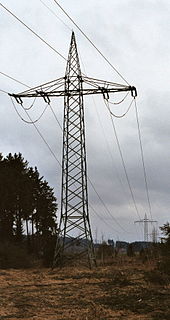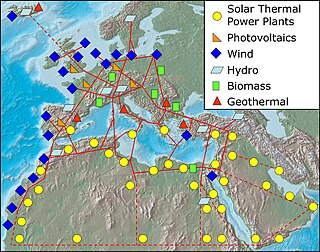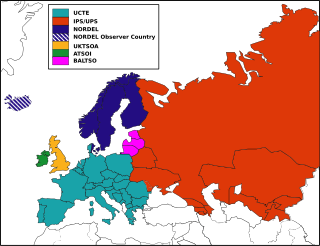
Electric power transmission is the bulk movement of electrical energy from a generating site, such as a power plant, to an electrical substation. The interconnected lines which facilitate this movement are known as a transmission network. This is distinct from the local wiring between high-voltage substations and customers, which is typically referred to as electric power distribution. The combined transmission and distribution network is known as the "power grid" in North America, or just "the grid". In the United Kingdom, India, Malaysia and New Zealand, the network is known as the "National Grid".

A high-voltage, direct current (HVDC) electric power transmission system uses direct current for the bulk transmission of electrical power, in contrast with the more common alternating current (AC) systems. For long-distance transmission, HVDC systems may be less expensive and suffer lower electrical losses. For underwater power cables, HVDC avoids the heavy currents required to charge and discharge the cable capacitance each cycle. For shorter distances, the higher cost of DC conversion equipment compared to an AC system may still be justified, due to other benefits of direct current links. HVDC uses voltages between 100 kV and 1,500 kV.

Electric power distribution is the final stage in the delivery of electric power; it carries electricity from the transmission system to individual consumers. Distribution substations connect to the transmission system and lower the transmission voltage to medium voltage ranging between 2 kV and 35 kV with the use of transformers. Primary distribution lines carry this medium voltage power to distribution transformers located near the customer's premises. Distribution transformers again lower the voltage to the utilization voltage used by lighting, industrial equipment or household appliances. Often several customers are supplied from one transformer through secondary distribution lines. Commercial and residential customers are connected to the secondary distribution lines through service drops. Customers demanding a much larger amount of power may be connected directly to the primary distribution level or the subtransmission level.

A substation is a part of an electrical generation, transmission, and distribution system. Substations transform voltage from high to low, or the reverse, or perform any of several other important functions. Between the generating station and consumer, electric power may flow through several substations at different voltage levels. A substation may include transformers to change voltage levels between high transmission voltages and lower distribution voltages, or at the interconnection of two different transmission voltages.

In the electricity sector in the United Kingdom the National Grid is the high-voltage electric power transmission network covering Great Britain, connecting power stations and major substations and ensuring that electricity generated anywhere on it can be used to satisfy demand elsewhere. The network covers the great majority of Great Britain and several of the surrounding islands. Notably, it does not cover Ireland; Northern Ireland is part of a single electricity market with the Republic of Ireland.

OAO RAO UES was an electric power holding company in Russia. It controlled about 70% of Russia's installed electric capacity, 96% of its high-voltage grid and over 70% of its transmission lines. In addition to the Russian market, RAO UES exported electricity to Scandinavia and to other members of the CIS. The last head of RAO UES was Anatoly Chubais.

The 15 kV, 16.7 Hz AC railway electrification system is used in Germany, Austria, Switzerland, Sweden, and Norway. The high voltage enables high power transmission with the lower frequency reducing the losses of the traction motors that were available at the beginning of the 20th century. Railway electrification in late 20th century tends to use 25 kV, 50 Hz AC systems which has become the preferred standard for new railway electrifications but extensions of the existing 15 kV networks are not completely unlikely. In particular, the Gotthard Base Tunnel still uses 15 kV, 16.7 Hz electrification.

The Electricity Act, 2003 is an Act of the Parliament of India enacted to transform the power sector in India.

The Power Grid Corporation of India Limited (POWERGRID), is an Indian state-owned electric utilities company headquartered in Gurugram, India. POWERGRID transmits about 50% of the total power generated in India on its transmission network. Its former subsidiary company, Power System Operation Corporation Limited (POSOCO) handles power management for National Grid and all state transmission utilities. POWERGRID also operates a telecom business under the name POWERTEL. Shri Ravi p. Singh serves as the Chairman and Managing Director of the company.

A transmission system operator (TSO) is an entity entrusted with transporting energy in the form of natural gas or electrical power on a national or regional level, using fixed infrastructure. The term is defined by the European Commission. The certification procedure for Transmission System Operators is listed in Article 10 of the Electricity and Gas Directives of 2009.

The synchronous grid of Continental Europe is the largest synchronous electrical grid in the world. It is interconnected as a single phase-locked 50 Hz mains frequency electricity grid that supplies over 400 million customers in 24 countries, including most of the European Union. In 2009, 667 GW of production capacity was connected to the grid, providing approximately 80 GW of operating reserve margin. The transmission system operators operating this grid formed the Union for the Coordination of Transmission of Electricity (UCTE), now part of the European Network of Transmission System Operators for Electricity (ENTSO-E).

The SuperSmart Grid (SSG) is a hypothetical wide area electricity network connecting Europe with northern Africa, the Middle East, Turkey and the IPS/UPS system of CIS countries. The system would unify super grid and smart grid capabilities into a comprehensive network. There are no planned locations for infrastructure or schedule explicitly for the SSG; the name is used to discuss the economic and technological feasibility of such a network and ways that it might gain political support.
OAO FGC UES is a state owned energy company located in Moscow, Russia. It is the largest electricity transmission grid company of Russia. The company is listed at the Moscow and London stock exchanges with 80.13% of shares owned by Rosseti.

PJM Interconnection LLC (PJM) is a regional transmission organization (RTO) in the United States. It is part of the Eastern Interconnection grid operating an electric transmission system serving all or parts of Delaware, Illinois, Indiana, Kentucky, Maryland, Michigan, New Jersey, North Carolina, Ohio, Pennsylvania, Tennessee, Virginia, West Virginia, and the District of Columbia.
Unified National Smart Grid as well as Unified Solar is a proposal for a United States wide area grid that is a national interconnected network relying on a high capacity backbone of electric power transmission lines linking all the nation's local electrical networks that have been upgraded to smart grids. Europe's analogous project is sometimes referred to as the SuperSmart Grid, a term that also appears in the literature describing the Unified Smart Grid.

An electrical grid, or electric grid, is an interconnected network for delivering electricity from producers to consumers. It consists of

A wide area synchronous grid is a three-phase electric power grid that has regional scale or greater that operates at a synchronized frequency and is electrically tied together during normal system conditions. Also known as synchronous zones, the most powerful is the synchronous grid of Continental Europe (ENTSO-E) with 667 gigawatts (GW) of generation, while the widest region served being that of the IPS/UPS system serving countries of the former Soviet Union. Synchronous grids with ample capacity facilitate electricity market trading across wide areas. In the ENTSO-E in 2008, over 350,000 megawatt hours were sold per day on the European Energy Exchange (EEX).

The IPS/UPS is a wide area synchronous transmission grid of some CIS countries with a common mode of operation and centralized supervisory control. It has an installed generation capacity of 300 gigawatts, and produces 1,200 terawatt-hours (TWh) per year for its 280 million customers. The system spans eight time zones.

Fabric computing or unified computing involves constructing a computing fabric consisting of interconnected nodes that look like a "weave" or a "fabric" when viewed/envisaged collectively from a distance.















